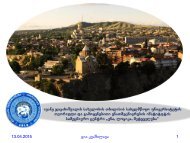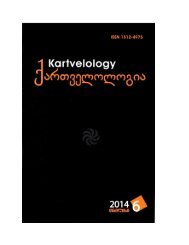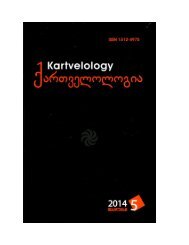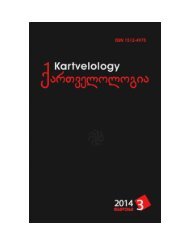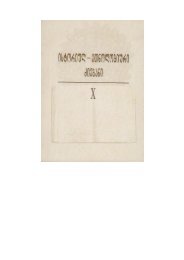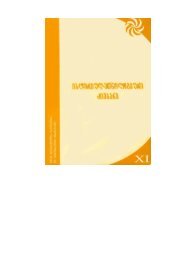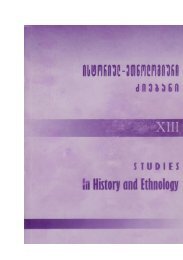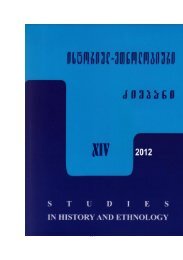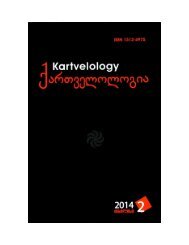Kvashilava, Gia, 2010. On Reading Pictorial Signs of the Phaistos Disk and Related Scripts (2). Rosette (in Georgian and English)
This study concerns the graphic character, symbolic meanings, typological parallels, commentaries and reading of the Phaistos Disk pictorial sign PHD38.
This study concerns the graphic character, symbolic meanings, typological parallels, commentaries and reading of the Phaistos Disk pictorial sign PHD38.
Create successful ePaper yourself
Turn your PDF publications into a flip-book with our unique Google optimized e-Paper software.
<strong>the</strong> oak‟s rough branches... For such was <strong>the</strong> m<strong>in</strong>d <strong>of</strong> Hera, that<br />
Aeaean Medea should come to sacred Iolchos, to <strong>the</strong> bane <strong>of</strong><br />
Pelias, leav<strong>in</strong>g her own country... But Aea still abides steadfast,<br />
<strong>and</strong> <strong>the</strong> children <strong>of</strong> those [Egyptian] men, whom that k<strong>in</strong>g [Pharaoh<br />
Sesostris] did plant <strong>the</strong>re<strong>in</strong> to dwell <strong>the</strong>re 1 ; <strong>the</strong>se men<br />
preserve writ<strong>in</strong>gs <strong>of</strong> <strong>the</strong>ir fa<strong>the</strong>rs, graved upon pillars, whereon<br />
are all <strong>the</strong> ways <strong>and</strong> limits <strong>of</strong> sea <strong>and</strong> dry l<strong>and</strong>, far <strong>and</strong> wide, for<br />
those who come thi<strong>the</strong>r.” (Coleridge 1889, 66, 95, 158, 137;<br />
Urushadze 1970, 351 7 , 352 8 ).<br />
A scholiast on Apollonius <strong>of</strong> Rhodes‟ Argonautica (Schol.<br />
ad Apoll. Rhod III, 1074, 1093; Merkel 1854, 474, 1074, 28-30;<br />
476, 1093, 1-3; Urushadze 1964, 330, 257) gives <strong>the</strong> follow<strong>in</strong>g<br />
explanation about <strong>the</strong> name <strong>of</strong> <strong>the</strong> isl<strong>and</strong> – Aeaea:<br />
”In Phasis <strong>the</strong>re is <strong>the</strong> isl<strong>and</strong> Aeaea where <strong>the</strong> fleece was<br />
kept. [Aeaea] is <strong>the</strong> capital <strong>of</strong> Colchis”;<br />
”The name <strong>of</strong> <strong>the</strong> isl<strong>and</strong>, Aeaeés is one syllable ae longer,<br />
because it is <strong>the</strong> isl<strong>and</strong> <strong>of</strong> Aea. Aea is <strong>the</strong> capital <strong>of</strong> Colchis. The<br />
isl<strong>and</strong> is mentioned <strong>in</strong> Phasis where, accord<strong>in</strong>g to Pherecydes <strong>of</strong><br />
Syros [was] <strong>the</strong> fleece”.<br />
Stephanus <strong>of</strong> Byzantium writes on Aea <strong>in</strong> his Ethnica<br />
1 . ”Aea is still <strong>the</strong>re – [Argos] says that Aea st<strong>and</strong>s unshakable <strong>and</strong> its<br />
<strong>in</strong>habitants are descendents <strong>of</strong> <strong>the</strong> people [<strong>of</strong> Egyptians] brought to settle<br />
<strong>the</strong>re by Sesostris [Egyptian<br />
– Sesonkosis] …”<br />
(Schol. ad Apol. Rhod. IV, 277; Merkel 1854, 497, 277, 6-8; Urushadze<br />
1964, 332). Comp.: Herodotus II, 103-105; Pl<strong>in</strong>y <strong>the</strong> Elder XXXIII, 15, 52<br />
(Bostock, Riley 1857, 93-94); also see: Lamberti 1991, 14-15.<br />
319




